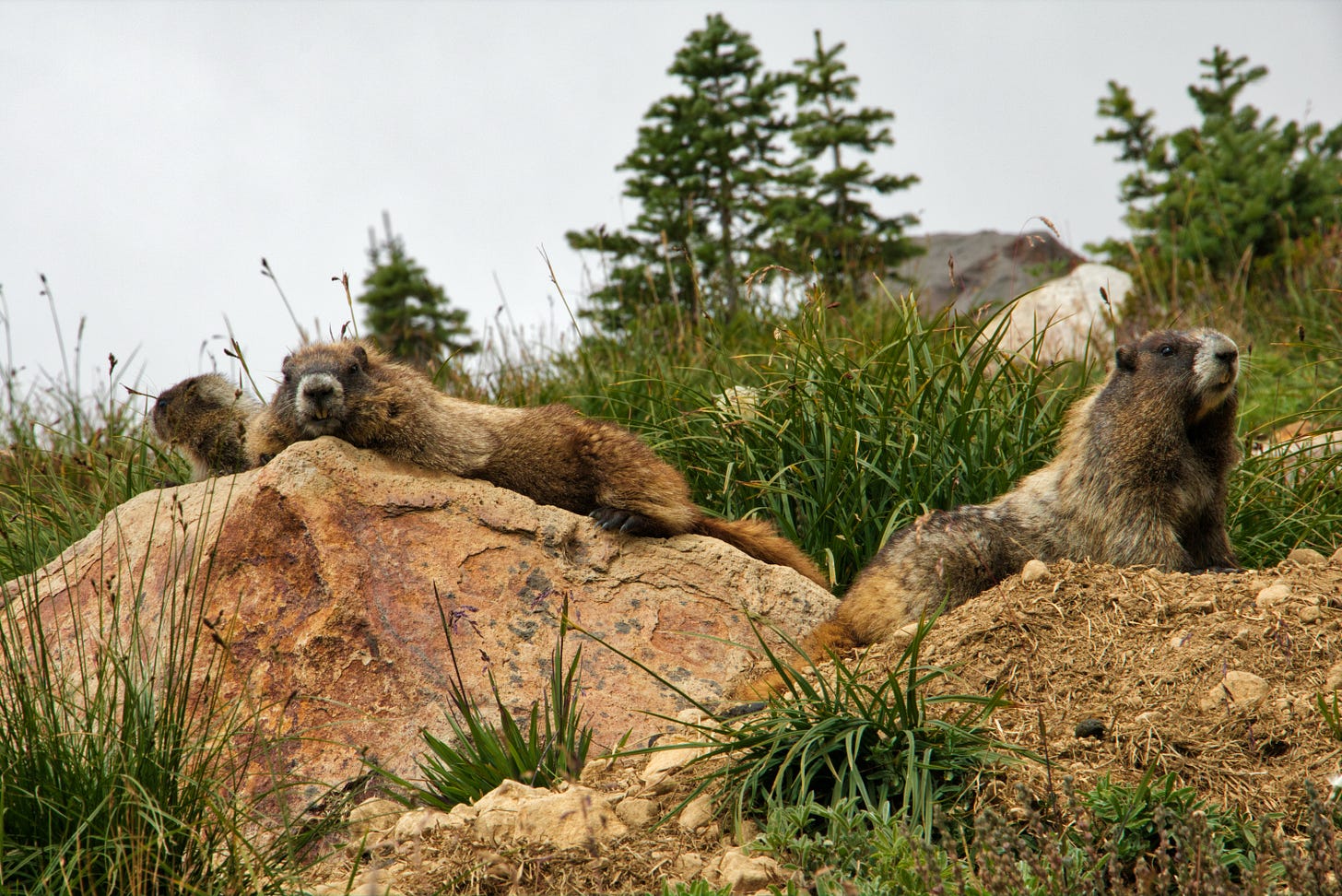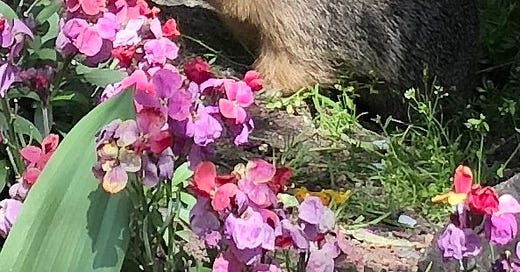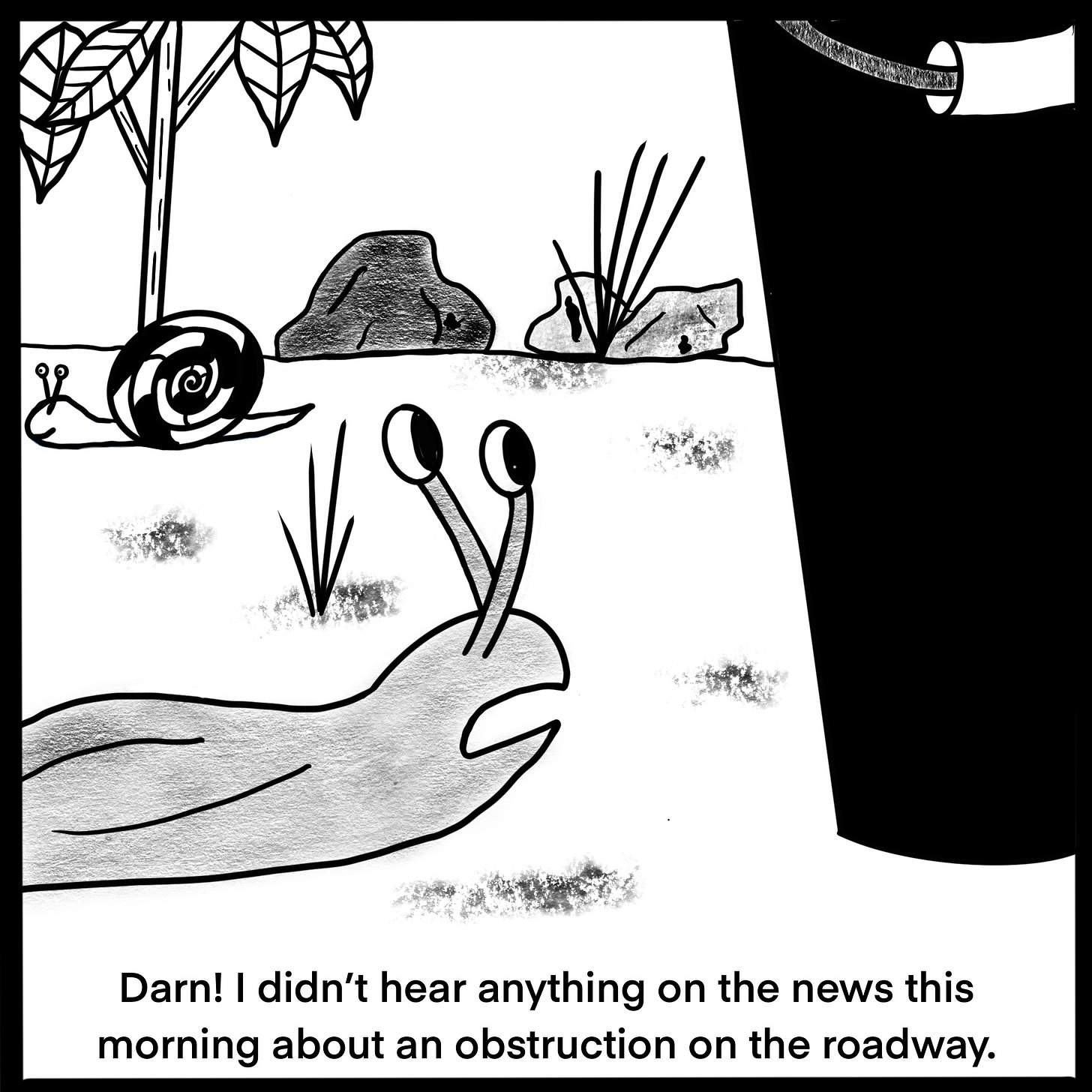What Do Gold-Digging Ants and Marmots Have in Common?
Greetings!
I hope wherever you live you are safe and warm - or safe and cool if it’s summer where you are. We’ve had a record-breaking snowstorm this week, followed by high winds and a super rare (for us) wind chill factor of below zero. Fortunately, we were prepared and have stayed home where we’ve barely been impacted. Our area was not hit as badly as some others. We are very grateful.
Max and Jasper are about the same as they have been. Jasper was feeling feisty today and went after his bully, Max, a few times. Hopefully, this is all course correction and they will soon go back to being nice to each other. Fingers crossed!
This Week
There’s not much to report for this week. Between the storm, some very sleepless nights, and the weather being way too cold to do stained glass in our garage, our week has been quite mundane. Actually, one thing we’ve been enjoying is starting our pellet stove (we also have electric heat so don’t often use the stove), taking our laptops to the couch, and working in our family room by the cozy fire. We’ve done this several days in a row. Not only do we love it, but so do Max, Jasper, and Kola.
Full Speed Ahead
What About…?
Marmots

Did you know that groundhogs, AKA woodchucks, are marmots? It’s true! Groundhogs are just one of 15 (some sources say 14) species of marmot of the genus Marmota, family of Sciuridae, which are squirrels, order of Rodentia.
That was a lot.
Here’s the main thing - groundhogs are just one of many types of marmots. Marmots are considered ground squirrels and exist in North America, Europe, and Asia. I’ve seen a few of these critters in my life when traveling, but never close to home, even though three different kinds of marmots can be found here in Washington State. It may be because most marmots are found in mountainous, often rocky, locations.
Marmots are short, stocky animals with short, thick fur. They weigh about 4.5-9 pounds (2-4 kg) and measure 16-26 inches (40-65 cm) long. Their coloring ranges from various shades of brown to black, white, and grays. Even the yellow-bellied marmot is more of a golden brown than yellow color.
Marmots really do look like big, chunky squirrels. If you don’t get hung up on the fact they are rodents, they’re pretty darn cute!
Marmots have long incisors, powerful jaws, and super strong claws for digging their often long and complex burrows that include places for sleeping, rearing their young, hibernating, and elimination. Yup - underground toilets!
Marmots are omnivorous but tend to eat mainly vegetation. They will eat insects, snails, and bird eggs when available.
Marmots hibernate for 6-9 months out of the year, depending upon the species. They are the largest mammal that truly hibernates. What about bears, you ask? Bears don’t actually hibernate. Hibernation is about energy conservation, and unlike marmots, they are too big to be able to lower their body temperature enough to go into true hibernation.
Marmots begin and end hibernation at the same biological age. Scientists hope that by understanding more about their metabolism, they may discover ways of slowing the aging process in humans which could be helpful with organ transplants and space travel.
Besides their main burrow, marmots may have smaller burrows used primarily for escaping predators. Most burrows have entrances and exits under rocks or boulders to make it difficult for predators to reach them. Their main predators include bears, coyotes, foxes, eagles, and badgers.
Marmots use a variety of chattering and whistling sounds to communicate with each other. They are often heard sounding loud whistles as a warning to others when something dangerous is nearby, resulting in a marmot exodus into their underground tunnels.
Most species of marmots are quite social, living in groups of 10-20. They greet each other with what we would call “kisses” and engage in play fighting. The main exception to this is groundhogs, who prefer a solitary lifestyle.
The whistling sound marmots make is the reason these creatures are also called whistle-pigs. Whistler Mountain in British Columbia was named after the whistling of the hoary marmots that live there.
Exploring More
What Do Gold-Digging Ants and Marmots Have in Common?

In North America, fossils reveal that marmot ancestors lived in the area at least 5.3 million years ago, and possibly as long as over 13 million years ago. In Europe and Asia, they date back no further than 2.6 million years, according to fossil evidence as well as cave paintings of marmots found in France. (Cool, right?)
Marmots have historically been favored for both their fur and meat. This was true on all three continents. Unfortunately, it may have also been this practice of eating marmots that helped spread the plague. Rats, or more specifically fleas on rats, usually get blamed for the Black Death plague of the mid-1300s, however, DNA evidence supports the theory that marmots were also heavily involved.
Scientists were able to compare present-day marmots carrying the bacteria Y. pestis, which causes the plague, with human remains of Black Death victims in order to track both the development of the disease and the pattern of dissemination. Four varieties of plague are currently in existence, but it is believed they all started as one and then a “genetic explosion” separated them. This likely occurred during the late 12th or early 13th century in the Tian Shan mountains, on the border between Kyrgyzstan and China.
So, how did the bacteria spread from China to Europe to begin the European plague rather than staying isolated in the mountains? Surely little marmots, who do not migrate and like to stay close to their burrows, could not have spread the disease on their own.
This is where we get back to people using marmots for fur and meat. It is theorized that the Mongols, known to hunt marmots, spread bacteria through pelts and meat as they carried on their conquests under Chinggis Khan. This would have taken the disease far and wide resulting in the spreading of four new plagues throughout Europe and Asia.
Sadly, this is not a practice relegated to history. In the journal Emerging Microbes & Infections, a detailed account of two Mongols who ate raw marmot meat and organs died from the plague in 2019.
If you’re up for a little more marmot history, how’s this? Herodotus, believed to be the first historian ever, was a Greek who lived in the 5th century B.C. and was known for his historical accounts. In his book, The Histories, Herodotus refers to a tribe in India that sends men out to hunt for gold. In this area, he says there are “great sand ants” that are smaller than dogs but bigger than foxes. They live in burrows and were known for digging up hills of sand that were filled with gold. The tribal gold hunters would carefully time their attack for the hottest part of the day when the ants would be sleeping in their tunnels and have less time to attack before they could collect the sand in bags and rush away
This was among many of the tales for which Herodotus was later labeled as a liar. Giant gold-digging ants were just too preposterous. However, over time, much linguistic research, conversations with indigenous people, and increasing information about mammal species, Herodotus was found to be correct. To keep this simple, it appears that during the 5th century B.C., there was a word that when translated meant “mountain ant,” it was the furry mammal we now know as the Himalayan marmot, and their habitat was, and possibly still is, sandy with flecks of gold.
Moving into the present day, marmots are considered both beloved creatures and reviled pests. Many locations around the world are known for their marmots including the Alps, various National Parks in the US, China, and various countries in Europe, and there are also sports teams named after marmots. People love the adorable creatures that often stand on their back legs as they survey the land for predators, or sun themselves on rocks. There are, however, many who do not enjoy marmots due to the damage they can cause. They can harm crops, home gardens, and landscaping both by eating the vegetation and burrowing under it. When their numbers are high, they are also known to cause vehicle damage by chewing through wiring, rubber hoses, and various plastic parts of parked vehicles.
Probably the most famous marmots are the weather-predicting groundhogs such as Punxsutawney Phil, Chattanooga Chuck, and Manitoba Merv (who is actually a puppet). The tradition came to North America as a German one that actually involved a hedgehog or a badger. It is suspected the switch to groundhogs was because they were more abundant and easier to find.
Groundhog Day is a fun tradition that claims if the groundhog emerges from his burrow and sees his shadow on February 2nd, there will be 6 more weeks of winter. Their track record for accuracy is fairly low with Punxsutawney Phi’s being 39% correct.
More interesting, in my opinion, is that real marmots actually do know when it’s going to be a long, hard winter. According to The Library of Congress, when they first emerge from hibernation, having lost up to half of their body weight, they can tell if there will be enough vegetation to support them. If not, coming out of hibernation and starting mating season is delayed.
There’s a lot more to know about marmots, but I want to leave you with this uplifting story. The Vancouver Island marmot is a species only found in very steep mountain areas of Vancouver Island, British Columbia. It has a distinct dark brown coat with white areas around its mouth and chest. Due to massive clear-cutting by the timber industry in the 1990s, the hunting range of their main predators, wolves, golden eagles, and cougars, was altered, resulting in the near elimination of the local marmots.
A field study in 2003 located only 22 remaining Vancouver Island marmots. Scientists estimated the species would be extinct in the wild within a year. Fortunately, the Marmot Recovery Foundation worked tremendously hard to reverse the trend. One of the first steps following the 2003 survey was to set up a 24/7 human shield to keep predators away from the marmots.
The Foundation’s breeding program had so far been a failure, but eventually, they realized they had to force the animals into hibernation by starving them, so they would be likely to wake up and breed. Their next challenge was helping the young marmot survive in the wild. The solution that is working is first introducing captive-bred marmots into a wild marmot colony on Mt. Washington where human activity keeps predators away and researchers can watch over them. After a year of learning from the local population, the captive-bred marmots are released into remote wilderness areas.
The latest population survey, conducted in 2021, found that the Vancouver Island marmots now number around 250, with about 50 pups being born each year.
Main References:
I hope you have a relaxing weekend. What is something you haven’t done in a while? Read a book, play a game, take a walk at a local park, paint, draw, go to a theater to see a movie, go bird watching? Whatever you can think of, maybe take the time to do it. I really enjoy mixing up my routine as a way to re-energize.
If you enjoyed this issue, please click on the heart at the bottom. This helps more people find my work and lets me know I should keep writing. :)
Thanks,
Dakota Duncan
You can support me by sharing this update with a friend. If you received this from someone else, go ahead and sign up for a free subscription of your very own here:
If you want to learn about my graphic novel or children's chapter books, please visit my website: dakotaduncan.com






